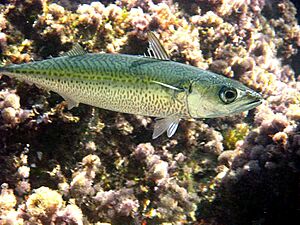Atlantic chub mackerel facts for kids
Quick facts for kids Atlantic chub mackerel |
|
|---|---|
 |
|
| Atlantic chub mackerel | |
| Conservation status | |
| Scientific classification | |
| Synonyms | |
|
The Atlantic chub mackerel (scientific name: Scomber colias), also known as Tinker mackerel, is a type of fish that swims in large groups. You can find it in the Atlantic Ocean, the Mediterranean Sea, and the Black Sea. It's a mackerel that lives in the open ocean, not near the bottom. People used to think it was just a different kind of chub mackerel.
Contents
What Does the Atlantic Chub Mackerel Look Like?
The Atlantic chub mackerel has a long, sleek body, perfect for swimming fast. Its tail is deeply forked, like a "V" shape. Its whole body is covered with very tiny fish scales. The first fin on its back has 9 or 10 pointy parts called spines. There's a gap between this first fin and the second fin on its back. The fin on its belly (called the anal fin) is usually right below or a little behind the second back fin. This fish is shiny silver. Its top side has cool zigzag lines, while its belly is lighter and might have spots or wavy lines.
What Does This Mackerel Do in the Ocean?
The Atlantic chub mackerel is a very important fish in the ocean's food chain. It's a "pelagic forage species," which means it lives in the open ocean and many other bigger animals, like sharks, dolphins, and larger fish, eat it. It helps keep the ocean healthy by being food for others.
How Are Atlantic Chub Mackerel Fished?
This fish is caught a lot, especially in the eastern Mediterranean Sea. Fishermen notice two main types of this fish:
- In late summer and autumn, the fish are fat and full of eggs (roe).
- In late winter and spring, they are very lean, almost thin.
The Greek names for these two types are koliós (for the fat one) and tsíros (for the lean one). People usually roast these fish. The fatter fish are often packed in salt so they can be eaten later. The fish releases its own oil into the salt, which helps it stay good for a very long time.
On the islands of the Aegean, there's a special dish called goúna. To make it, fresh mackerel is cut open, cleaned, and left to dry in the sun for a day, with the flesh side facing up. That same evening, it's quickly cooked over a fire and then served with lemon juice.
Along the eastern coast of North America, people didn't really fish for Atlantic chub mackerel for business until 2013. That's when large fishing boats started catching them because there weren't enough squid to catch. Because of this, the amount of mackerel caught went from almost nothing to 5 million pounds in just one year!
What is the Status of This Fish?
The Atlantic chub mackerel lives in many different places and is quite common in some areas. Even though a lot of these fish are caught, their population seems to be pretty stable. Because of this, the IUCN (International Union for Conservation of Nature) has listed this species as Least Concern. This means they are not worried about it becoming endangered anytime soon.
See Also
Links
- Scomber colias at FishBase
- USDOI: Fishes of the Gulf of Maine
Images for kids
-
Atlantic chub mackerel bought at a Roman fish market



